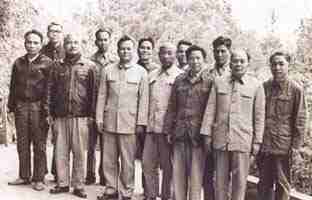Lao People's Revolutionary Party
|
|
The Lao People's Revolutionary Party (Laotian: Phak Pasason Pativat Lao) is the Communist Party of Laos. Since 1975, it has monopolized political power in the country. The policy-making organs are the politburo and the central committee. A Party Congress, which elects members to the politburo and central committee, is held every five years. The Congress used to also elect a secretariat but this body was abolished in 1991.
History
The party has its origins in the Indochinese Communist Party founded by Ho Chi Minh in 1930 (see Communist Party of Vietnam). The ICP was entirely Vietnamese at its inception but grew throughout French Indochina and was able to found a small "Lao section" in 1936. In the mid-1940s, a campaign to recruit Laotian members was instigated and in 1946 or 1947, Kaysone Phomvihan, a law student at the University of Hanoi, was recruited, along with Nouhak Phoumsavan.
In February 1951, the Second Congress of the ICP resolved to disband the party and to form three separate parties representing the three states of Indochina. A movement known as the Pathet Lao (Land of Laos) was founded by Prince Souphanouvong as a communist resistance movement to fight alongside the Viet Minh against French colonialism during the first Indochina War, but it was not until March 22, 1955, at its First Party Congress, that the clandestine Lao's People's Party or Phak Pasason Lao was officially proclaimed. The First Party Congress was attended by 25 delegates representing a party membership of 300 to 400. The LPP and its successor the LPRP kept their existence secret until 1975 preferring to direct its activities through fronts such as the Pathet Lao.
In 1956 a legal political wing of the Pathet Lao, the Lao Patriotic Front (Neo Lao Hak Xat), was founded and participated in several coalition governments. In the 1960s the Pathet Lao fought a civil war against the U.S.-backed Laotion government and was able to win control in the northern and eastern sectors of the country.
In February 1972, at the Second Party Congress, the name of the Lao's People's Party was changed to the Lao People's Revolutionary Party.
In the spring of 1975 Pathet Lao forces consolidated their power throughout the country. The American backed government fell in May 1975 and the LPRP took power.
The Third Party Congress did not meet until April 1982. Since then Party Congresses have been more regular with the Fourth Party Congress being held in November 1986, and the Fifth Party Congress in March 1991 with further congresses every four or five years since then.
Party Structure
From a membership of a few hundred at its founding the party grew to 11,000 members by 1965 and 21,000 members by 1972. When the party seized power in 1975 it claimed a membership of 25,000; and by 1991, at the convening of the Fifth Party Congress, the LPRP claimed its membership had increased to 60,000 or just over 1% of the population.
The Central Committee of the party was composed of 21 members and 6 alternates in 1975. This expanded to 51 members and 9 alternates by 1986 and 59 members in 1991.
The Politburo is the centre of political power in the party with its membership drawn from and chosen by the Central Committee. The Politburo consisted of seven members in 1972 growing to eleven members by 1993.
Kaysone Phomvihan was the party's general secretary from its founding in 1955 and remained the party's key figure until his death in 1992. His title changed to Party Chairman in 1991. Nouhak Phoumsavan was the second most powerful figure in the party throughout from the party's founding until Kaysone's death when he became the party's titular leader.
The party is currently led by party and national president Khamtai Siphandon, who succeeded Nouhak Phoumsavan in 1998 (although some accounts have him succeeding Kayonse in 1992). Other recent leading figures have included Sisavath Kheobounphanh and Boungnang Vorachith, who have each served as prime minister.
The party operates according to the principles of democratic centralism. Due to the covert nature of the party in its first two decades it remains semi-secret in its operations though it is becoming more open as a new generation takes control.
Ideology
The LPRP is a Marxist-Leninist party patterned after the Vietnamese Communist Party and strongly influenced by the Soviet Union and the USSR's Communist Party. In the late 1980s the party attempted to follow the example of Gorbachev's perestroika reforms by introducing market measures and reducing controls over state run enterprises as well as abandoning attempts at agricultural collectivisation. These reforms have been expanded in the 1990s. However, the Laotian party was reticent to follow the Soviet example of glasnost and has avoided loosening the party's political monopoly in the country or allowing for a free press.
See also:

